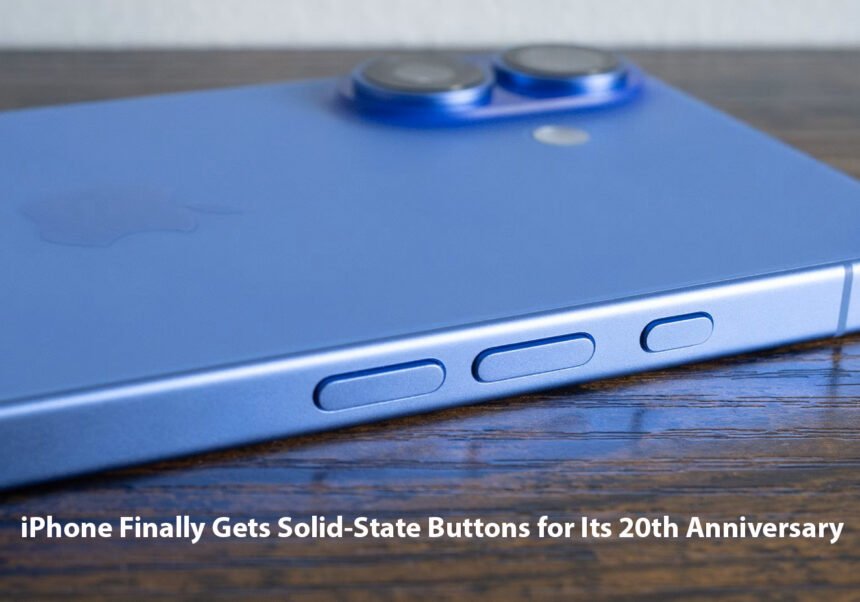As Apple approaches the 20th anniversary of the iPhone in 2027, new reports suggest that the company is preparing a major design evolution. The tech giant is rumored to introduce solid-state buttons, replacing the traditional physical ones that have been a staple of the iPhone since its debut in 2007. This change would not only mark a symbolic celebration of two decades of innovation but also represent a leap forward in durability, design, and user experience.
A New Era of iPhone Design
Apple has always been known for its pursuit of minimalism and precision. The move toward solid-state buttons fits perfectly within that philosophy. Instead of using mechanical components, the new buttons are expected to rely on haptic feedback generated by Apple’s Taptic Engine technology. When pressed, the surface would simulate the feeling of a click, even though no physical movement occurs. This approach offers several key benefits. Without moving parts, the buttons are less likely to wear out over time.
The elimination of small gaps also means the iPhone’s frame can become more resistant to dust and water, improving overall durability. For Apple, this aligns with its long-standing goal of creating a seamless, unified design that seamlessly blends hardware and software into a cohesive experience.
Building on a Proven Concept
Apple already experimented with solid-state technology in 2016 when it redesigned the iPhone 7’s Home button. That version introduced users to haptic feedback that convincingly mimicked the sensation of pressing a real button. The experiment was well received, setting the stage for broader adoption across the entire iPhone lineup.
According to industry sources, Apple has been refining the concept ever since. The upcoming generation of iPhones, potentially the iPhone 17 Pro or later models, could finally feature this innovation on the volume and power buttons. The result would be a phone that feels futuristic and even more resistant to external damage.
Engineering Challenges and Solutions
Introducing solid-state buttons is not as simple as it may sound. The design requires precise engineering to ensure that pressure sensitivity is uniform across the surface. Apple’s hardware teams have reportedly developed advanced pressure sensors capable of detecting even slight variations in user input.
To enhance feedback accuracy, Apple plans to include multiple Taptic Engines strategically placed around the device. This would ensure a consistent tactile experience regardless of where a button is pressed. Engineers have also worked on improving the device’s energy efficiency so that the haptic system doesn’t consume excessive power.
A Symbolic Move for the 20th Anniversary
Launching such a major change on the iPhone’s 20th anniversary would be a symbolic tribute to Apple’s innovation legacy. The company’s first iPhone revolutionized mobile technology by eliminating physical keyboards and introducing a multi-touch screen. Two decades later, Apple could again redefine how users interact with their devices, this time by removing mechanical buttons altogether. Industry watchers believe this transformation could also signal Apple’s long-term ambition: creating a completely portless and buttonless iPhone.
By removing more physical components, Apple could enhance structural integrity, simplify assembly, and reduce the number of points of failure. Eventually, charging and data transfer might rely entirely on wireless systems, further supporting Apple’s environmental sustainability goals.
How Users Might React
The introduction of solid-state buttons will likely divide opinions at first. Some users enjoy the tactile satisfaction of real, mechanical clicks. Others will appreciate the modern aesthetic and technological sophistication of haptic feedback. Apple is confident that users will adapt quickly once they experience the new system firsthand, just as they did with the Home button change and the transition from Touch ID to Face ID.
Moreover, the improved resistance to water and dust could be a compelling selling point for many. Since modern iPhones are already rated with strong water resistance, eliminating physical gaps could make the devices even more durable for outdoor use or in extreme environments.
The Future of the iPhone Experience
If the rumors hold true, the iPhone’s 20th anniversary will mark not only a nostalgic milestone but also a turning point in smartphone design. The addition of solid-state buttons would reinforce Apple’s reputation as a pioneer that constantly redefines the boundaries of technology and aesthetics.
For users, this could mean a more seamless experience, one that feels smoother, sturdier, and more intuitive. For Apple, it’s another step closer to its ultimate vision: a perfectly unified device with no moving parts, built to last for years while maintaining its elegant simplicity.
As anticipation builds, one thing is certain: Apple intends to celebrate two decades of iPhone history by looking boldly toward the future.












